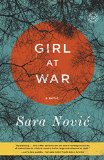Summary | Excerpt | Reviews | Beyond the Book | Read-Alikes | Genres & Themes | Author Bio

This article relates to Girl at War
 The Civil War that led to the breakup of Yugoslavia consisted of a number of separate but related ethnic conflicts spanning the period 1991 to 2001. Sara Novic's debut novel, Girl at War, zeroes in on the Croatian War of Independence, which lasted from 1991 to 1995.
The Civil War that led to the breakup of Yugoslavia consisted of a number of separate but related ethnic conflicts spanning the period 1991 to 2001. Sara Novic's debut novel, Girl at War, zeroes in on the Croatian War of Independence, which lasted from 1991 to 1995.
The United Nations estimates that 3,000 to 4,000 child soldiers (some as young as 10) took part in the fighting, most of them in Bosnia and Croatia, though other sources put the numbers at more like 10,000. The Croatian Ministry of Defence has denied that they ever actively recruited children. A UNICEF statement insists that "children under 18 years were not obliged to participate in military forces, very few of them joined the military forces as volunteers, and they were accepted only if they were older than 16 years."
Still, the truth is that many underage children volunteered to fight, and a surprising number of these were girls. For instance, Ramiza Variz and her sister, both from Sarajevo, joined Bosnia's government army when they were children. Ramiza fought on the front lines for four years and still has the scar from a wound she received in 1993. "I don't regret joining the army," she said in the article "Bosnia's Forgotten Child Soldiers"; "I only regret that I didn't have a normal childhood." She now serves as the chair of Bosnia and Hercegovina's Association of Underage Soldiers.
Nenad Bukvic, who fought for the Bosnian Serbs in 1992, when he was only 17, reflects in the same article, "I don't have another homeland, and if I were forced to defend myself again, I would do that. But I wouldn't allow my child to do what I did. I wouldn't want any child in the world to experience what I did during the war." (There are many other stories just like Bukvic's in "Bosnia's Forgotten Child Soldiers.")
UNICEF, the children's rights and emergency relief group, believes that there are currently nearly 250,000 child soldiers involved in 20 armed conflicts worldwide. Some of these soldiers are as young as eight. War Child (a UK charity) reports that most underage soldiers are in Africa (especially Congo, the Ivory Coast, Libya, Mali, Sudan, and South Sudan), and up to 40% are girls. An April 2009 UNICEF report on children in armed conflicts names the main detrimental effects of their experiences as missing out on childhood and educational opportunities, and physical and mental trauma.
In 2012 The Atlantic posted an arresting photo essay marking the 20th anniversary of the Bosnian War. See especially image #18, which depicts a young woman acting as a sniper (as Ana does in Girl at War).
Daily routine at Stradun during the 1991 Croatian War, courtesy of DIREKTOR
Filed under People, Eras & Events
![]() This "beyond the book article" relates to Girl at War. It originally ran in June 2015 and has been updated for the
March 2016 paperback edition.
Go to magazine.
This "beyond the book article" relates to Girl at War. It originally ran in June 2015 and has been updated for the
March 2016 paperback edition.
Go to magazine.
Your guide toexceptional books
BookBrowse seeks out and recommends the best in contemporary fiction and nonfiction—books that not only engage and entertain but also deepen our understanding of ourselves and the world around us.